Marrying Vega and Zen: The AMD Ryzen 5 2400G Review
by Ian Cutress on February 12, 2018 9:00 AM ESTBenchmarking Performance: CPU Encoding Tests
One of the interesting elements on modern processors is encoding performance. This includes encryption/decryption, as well as video transcoding from one video format to another. In the encrypt/decrypt scenario, this remains pertinent to on-the-fly encryption of sensitive data - a process by which more modern devices are leaning to for software security. Video transcoding as a tool to adjust the quality, file size and resolution of a video file has boomed in recent years, such as providing the optimum video for devices before consumption, or for game streamers who are wanting to upload the output from their video camera in real-time. As we move into live 3D video, this task will only get more strenuous, and it turns out that the performance of certain algorithms is a function of the input/output of the content.
All of our benchmark results can also be found in our benchmark engine, Bench.
7-Zip 9.2: link
One of the freeware compression tools that offers good scaling performance between processors is 7-Zip. It runs under an open-source licence, is fast, and easy to use tool for power users. We run the benchmark mode via the command line for four loops and take the output score.
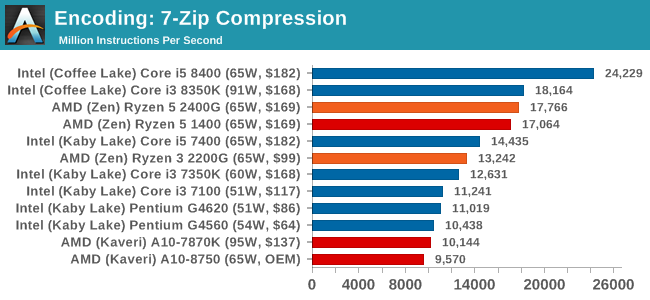
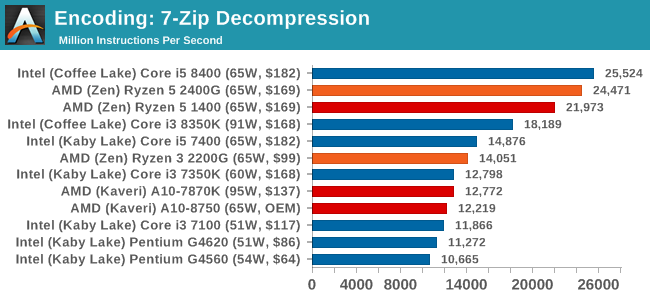
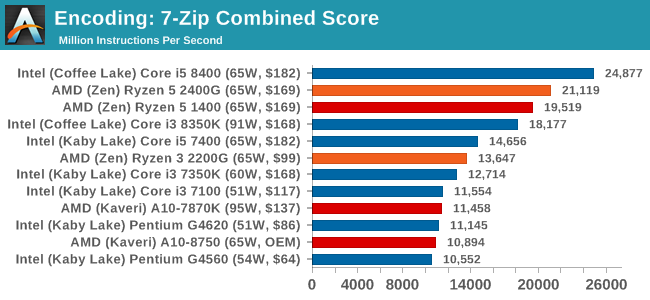
7-zip gives two contrasting stories here. For compression, full cores are needed to get the best performance, with frequency helping as well. However, for decompression, the extra threads help a lot. The combined result looks more like the decompression score, with the Ryzen 5 2400G sitting between the six-core Core i5-8400 and the quad-core Core i3-8350K.
WinRAR 5.40: link
For the 2017 test suite, we move to the latest version of WinRAR in our compression test. WinRAR in some quarters is more user friendly that 7-Zip, hence its inclusion. Rather than use a benchmark mode as we did with 7-Zip, here we take a set of files representative of a generic stack (33 video files in 1.37 GB, 2834 smaller website files in 370 folders in 150 MB) of compressible and incompressible formats. The results shown are the time taken to encode the file. Due to DRAM caching, we run the test 10 times and take the average of the last five runs when the benchmark is in a steady state.
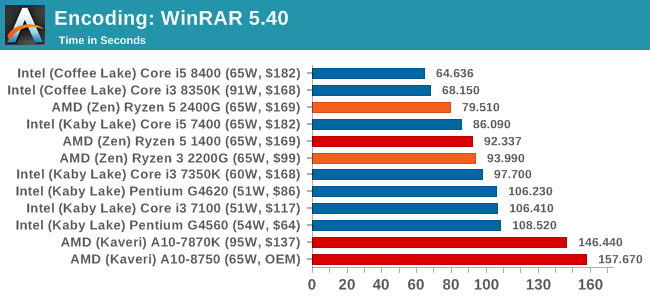
WinRAR is a good scaler with cores, frequency, and memory performance. The eight threads and DDR4-2933 contributes a good amount to the performance here, especially in light of where AMD was. The jump from the Ryzen 5 1400 to the 2400G is also noticable, due to the uptick in frequency and memory speed. The high single-thread performance of the Intel cores still wins out, however.
AES Encoding
Algorithms using AES coding have spread far and wide as a ubiquitous tool for encryption. Again, this is another CPU limited test, and modern CPUs have special AES pathways to accelerate their performance. We often see scaling in both frequency and cores with this benchmark. We use the latest version of TrueCrypt and run its benchmark mode over 1GB of in-DRAM data. Results shown are the GB/s average of encryption and decryption.
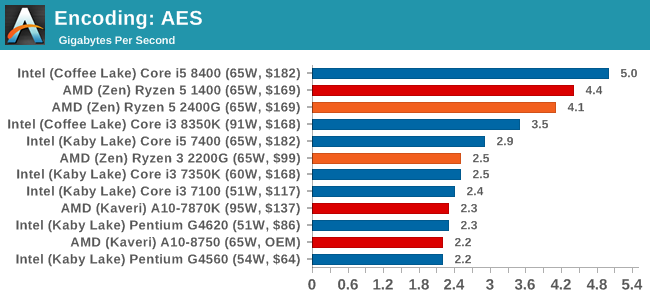
HandBrake v1.0.2 H264 and HEVC: link
As mentioned above, video transcoding (both encode and decode) is a hot topic in performance metrics as more and more content is being created. First consideration is the standard in which the video is encoded, which can be lossless or lossy, trade performance for file-size, trade quality for file-size, or all of the above can increase encoding rates to help accelerate decoding rates. Alongside Google's favorite codec, VP9, there are two others that are taking hold: H264, the older codec, is practically everywhere and is designed to be optimized for 1080p video, and HEVC (or H265) that is aimed to provide the same quality as H264 but at a lower file-size (or better quality for the same size). HEVC is important as 4K is streamed over the air, meaning less bits need to be transferred for the same quality content.
Handbrake is a favored tool for transcoding, and so our test regime takes care of three areas.
Low Quality/Resolution H264: Here we transcode a 640x266 H264 rip of a 2 hour film, and change the encoding from Main profile to High profile, using the very-fast preset.
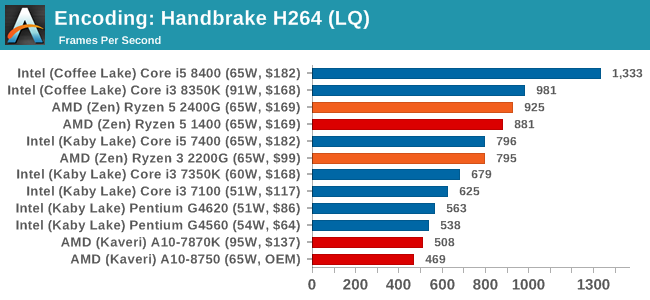
High Quality/Resolution H264: A similar test, but this time we take a ten-minute double 4K (3840x4320) file running at 60 Hz and transcode from Main to High, using the very-fast preset.
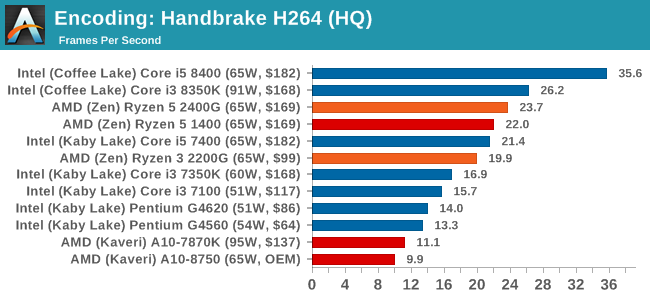
HEVC Test: Using the same video in HQ, we change the resolution and codec of the original video from 4K60 in H264 into 4K60 HEVC.
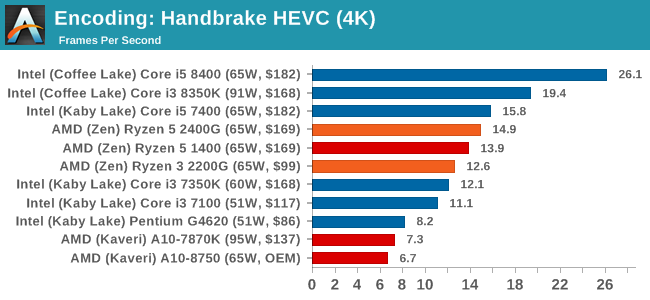










177 Comments
View All Comments
haplo602 - Tuesday, February 13, 2018 - link
Finally one review where I can see the driver version ... So this is the same driver used also for the Ryzen mobile APUs. Can you check if you can force/manual install the latest Adrenaline drivers ? That works on some of the Ryzen 2500u chips and actually increases the performance by some 15+% ...haplo602 - Tuesday, February 13, 2018 - link
I hope there's a memory scaling article in the future with frequency and CL scaling for the APU part ...crotach - Tuesday, February 13, 2018 - link
What about HTPC use?I was considering GT 1030 + Intel route for H265 and HDR10 playback and was really looking forward to Zen APUs, but there doesn't seem to be any motherboards with HDMI 2.0?!
Also, I wonder if the chips can be undervolted and underclocked to bring them to a near silent noise level for the living room.
Lolimaster - Tuesday, February 13, 2018 - link
You can undervolt and underclock ANY intel or amd cpu.forgerone - Tuesday, February 13, 2018 - link
What most writers and critics of integrated graphics processors such as AMD's APU or Intel iGP all seem to forget, is not EVERYONE in the world has a disposable or discretionary income equal to that of the United States, Europe, Japan etc. Not everyone can afford bleeding edge gaming PC's or laptops. Food, housing and clothing must come first for 80% of the population of the world.An APU can grant anyone who can afford at least a decent basic APU the enjoyment of playing most computer games. The visual quality of these games may not be up to the arrogantly high standards of most western gamers, but then again these same folks who are happy to have an APU also can not barely afford a 750p crt monitor much less a 4k flat screen.
This simple idea is huge not only for the laptop and pc market but especially game developers who can only expect to see an expansion of their Total Addressable Market. And that is good for everybody as broader markets help reduce the cost of development.
This in fact was the whole point behind AMD's release of Mantle and Microsoft and The Kronos Group's release of DX12 and Vulkan respectively.
Today's AMD APU has all of the power of a GPU Add In Board of not more than a several years back.
krazyfrog - Tuesday, February 13, 2018 - link
Why did you leave out the 8400 and the 1500X in these comparisons?Kamgusta - Wednesday, February 14, 2018 - link
Because these CPUs, while having the same price range, outperform these Raven Ridge chips. That would have been a bad press for AMD and it seems like Anandtech wants to remains extremely loyal to AMD in these days.msroadkill612 - Tuesday, February 13, 2018 - link
"the data shows both how far integrated graphics has come, and how far it still has to go to qualify for those 'immerse experiences' that Intel, AMD, and NVIDIA all claim are worth reaching for, with higher resolutions and higher fidelity. "This assumes a static situation which is rot.
what it reveals is that in the current paradigm, coders have coded accordingly for satisfactory results. If the paradigm changes and other ways work better, then code evolves.
This unprecedented integration of new gen, sibling cpu & gpu, offers many performance upsides too for future code.
picture a mobo with a discrete gpu like an equivalent 1030, then picture a ~matchbox footprint apu - there is a huge difference in the size of the respective circuits - yet they both do the same job & have to send a lot of data to each other.
it's not hard to figure which is inherently superior in many ways.
I strongly disagree with your blinkered bias.
Pork@III - Tuesday, February 13, 2018 - link
There is something unfinished, something inconsolable.elites2012 - Tuesday, February 13, 2018 - link
anything this chip lost to intel at, was most likely outdated. adobe, fcat, dolphin, pov are all outdated benchmarks.